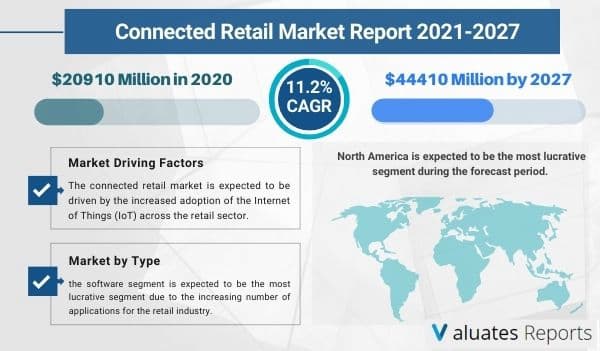
The global Connected Retail market size is projected to reach US$ 44410 million by 2028, from US$ 20910 million in 2021, at a CAGR of 11.2% during 2022-2028. Key drivers of the connected retail market include the rapid digitization and proliferation of IoT-connected devices in the retail industry.
The advent of omnichannel retailing will fuel the growth of the connected retail market in the coming years.
The reduction in costs of sensors and RFID tags will be beneficial for retailers in turn driving the expansion of the market during the forecast period.

Internet of Things
Connected retail promotes easy collaboration between various stakeholders and decreases operating costs by following a lean structure. The pandemic-fueled rise of digitization has changed consumer buying habits completely. Smartphones, wearables, tablets, and portable connected devices are penetrating the retail industry. This will expand the growth of the connected retail market during the forecast period. The use of sensors through retail IoT devices helps in data collecting, gathering, and gaining information on the entire product lifecycle which gives detailed insights to managers for making informed decisions and improving the consumer experience. The connected machines collect crucial data both from in-store purchases and online websites to drive resiliency and efficiency. Nowadays, a customer’s buying journey is very complex. Sensors can accurately track and analyze their habits so that content managers can introduce hypersegmentation practices and create a personalized shopping experience for customers. It also helps in optimizing product usage and maintenance. Connected retail can track other vital metrics like customer wait time at counters to make the shopping experience convenient, fun, and memorable. Moreover, IoT devices like drones monitor inventories and fastrack the warehouse management process.
The advent of omnichannel retail experience
The rapid boom of the eCommerce industry has forced big retail companies to adopt multiple marketing channels to cater to the varying needs of a wide group of consumers. It is no longer a nice-to-have feature. Organizations need to adapt and incorporate omnichannel strategies to remain competitive. A seamless shopping experience across several touchpoints is crucial as consumers are discovering brands in newer ways. This will bolster the growth of the connected retail market in the forthcoming years. Customers want to buy as per their preferred channel. Hence brands are using omnichannel techniques to sell products at their convenience using connected retail. It increases customer loyalty and retention. With round-the-clock real-time support and variable payment feature, client satisfaction reaches new levels. Combining online and offline experiences creates long-term value and trust.
RFID tags and sensors
Radiofrequency identification tags are getting cheaper and retailers are increasingly using this technology for faster inventory counting. It uses radio waves to detect the tags attached to the objects. The electronically stored information is read through portable handheld devices. This leads to improved shipping accuracy and reduced wastage of inventory. The chances of over or underproduction are decreased significantly in turn driving the growth of the connected retail market during the forecast period. Stocks are replenished quickly and out-of-stock situations are avoided to a larger extent thereby increasing customer satisfaction. The real-time viewing systems trigger automatic alerts across the entire supply chain process. Moreover, the key performance is measured efficiently with detailed analytics on visual dashboards. The reliance on historical data is avoided completely.
Based on type, the hardware segment is expected to dominate in the connected retail market share due to the proliferation of connected devices at retailers and consumer levels. The extensive use of sensors, RFID tags, and communication chips for monitoring customer behavior. On the other hand, the software segment will grow the fastest due to the deployment of IoT-based services for gathering important information.
Based on application, the segmentations include industrial and enterprise.
Based on region, North America will be the most lucrative during the forecast period due to rapidly expanding IoT infrastructure and huge demand for connected solutions in retail for reducing operational costs, driving employee efficiency, and improving the consumer experience.
|
Report Metric |
Details |
|
Report Name |
Connected Retail Market |
|
The market size in 2020 |
USD 20910 Million |
|
The revenue forecast in 2027 |
USD 44410 Million |
|
Growth Rate |
CAGR of 11.2% from 2021 to 2027 |
|
Base year considered |
2019 |
|
Market size available for years |
2021-2027 |
|
Forecast units |
Value (USD) |
|
Segments covered |
Type, End-User, Offerings, and Region |
|
Report coverage |
Revenue & volume forecast, company share, competitive landscape, growth factors, and trends |
|
Geographic regions covered |
North America, Europe, Asia Pacific, Latin America, Middle East & Africa |
Ans. The global connected retail market size is projected to reach USD 44410 Million by 2027, from USD 20910 Million in 2020, at a CAGR of 11.2% during the forecast period 2021-2027.
Ans. The introduction of IoT into the retail industry has radically altered the retail landscape. The integration of IoT sensors in various consumer gadgets will help merchants to analyze and monitor customer behavior, collect data, and give a superior consumer experience. These advantages are offered is expected to drive the growth of the connected retail market.
Ans. The major vendors operating in the connected retail market include Brands, Zebra technologies, Softweb Solutions, SAP, PTC Inc, Microsoft, Intel, IBM, Cisco Systems, Atmel, ARM, Others.
Ans. The forecast period for the connected retail market is 2021 to 2027
Ans. Based on type, the software segment is expected to be the most lucrative segment due to the increasing number of applications for the retail industry.
Ans. Based on retail, North America is expected to be the most lucrative segment during the forecast period.
$3900
$5850
$7800
HAVE A QUERY?
OUR CUSTOMER

SIMILAR REPORTS